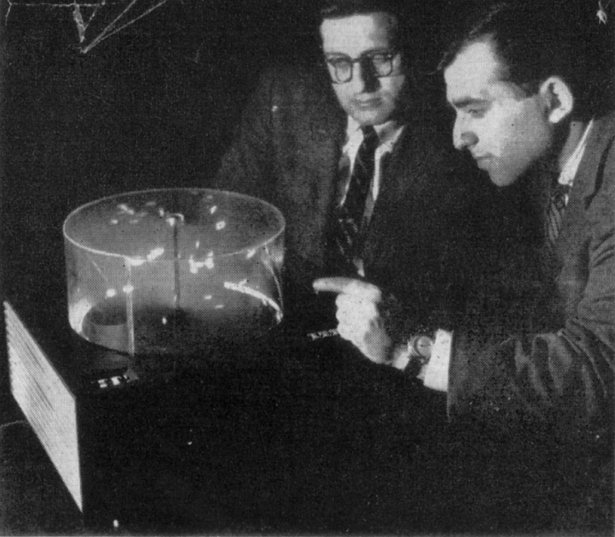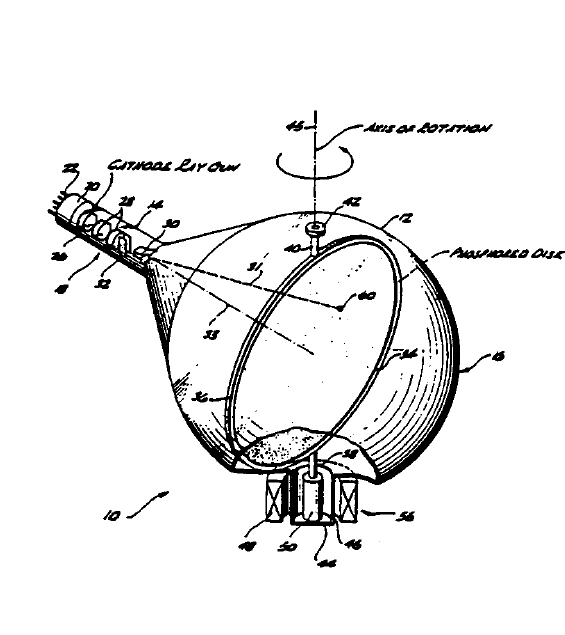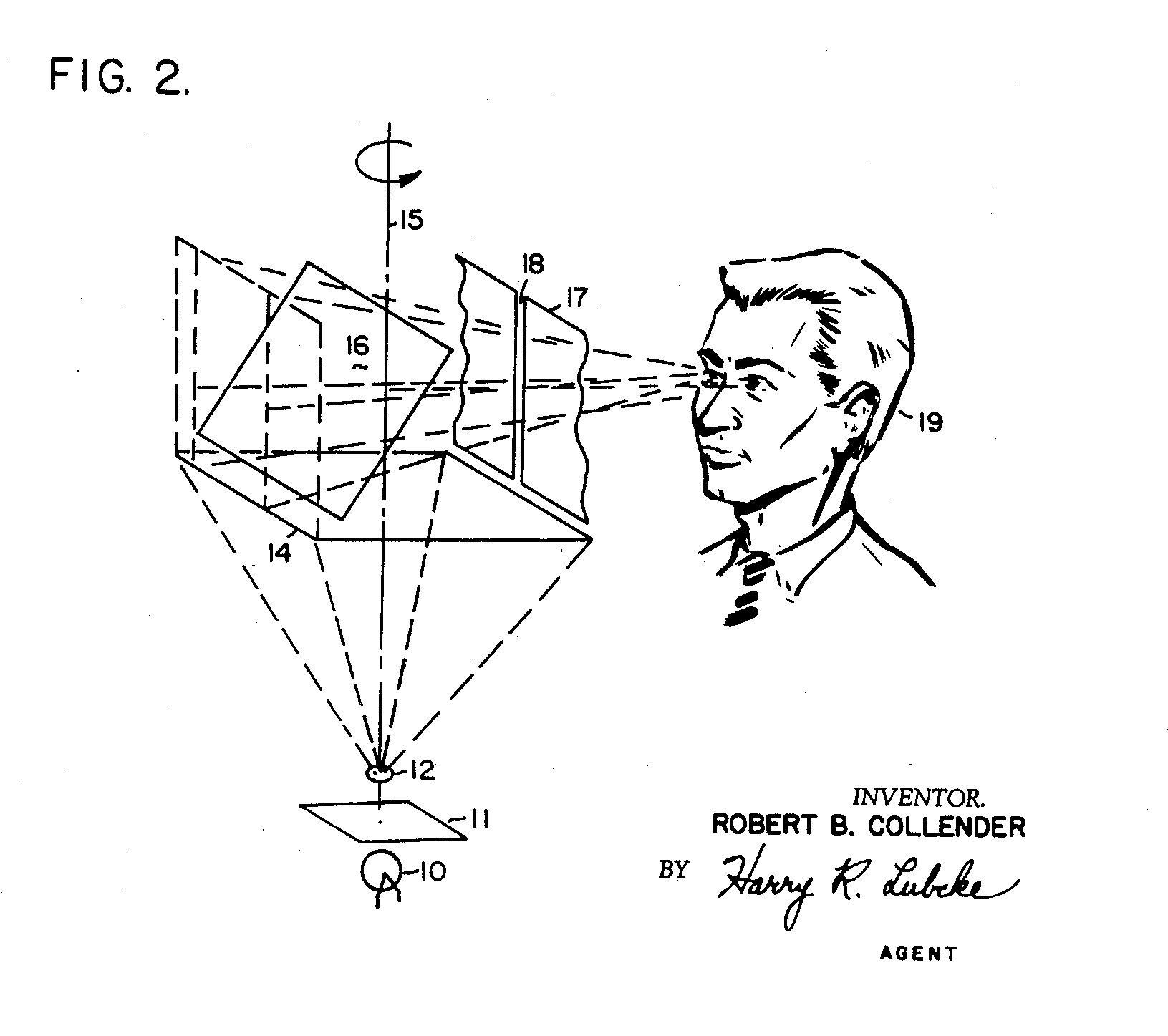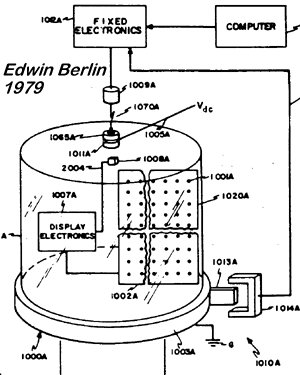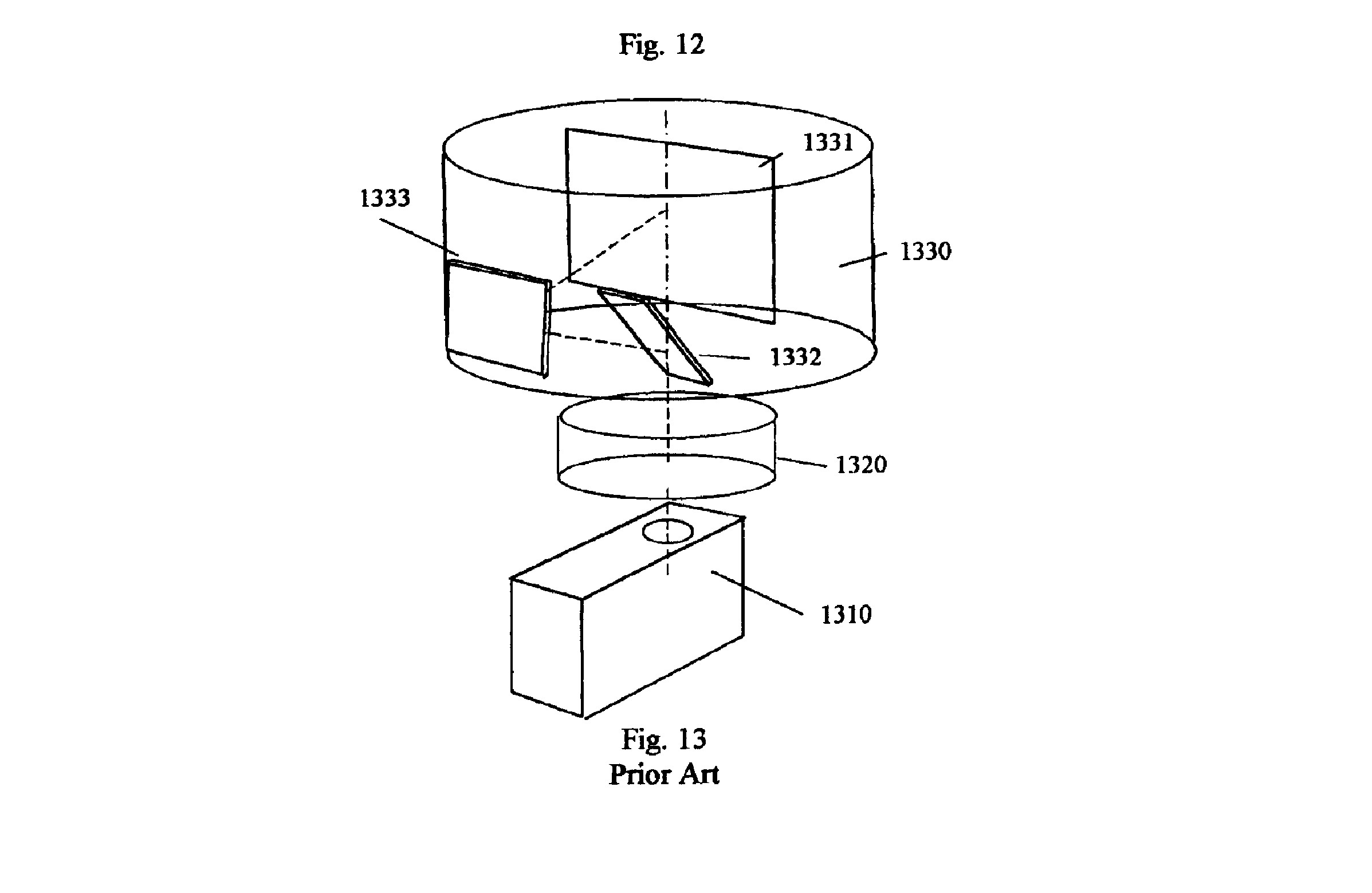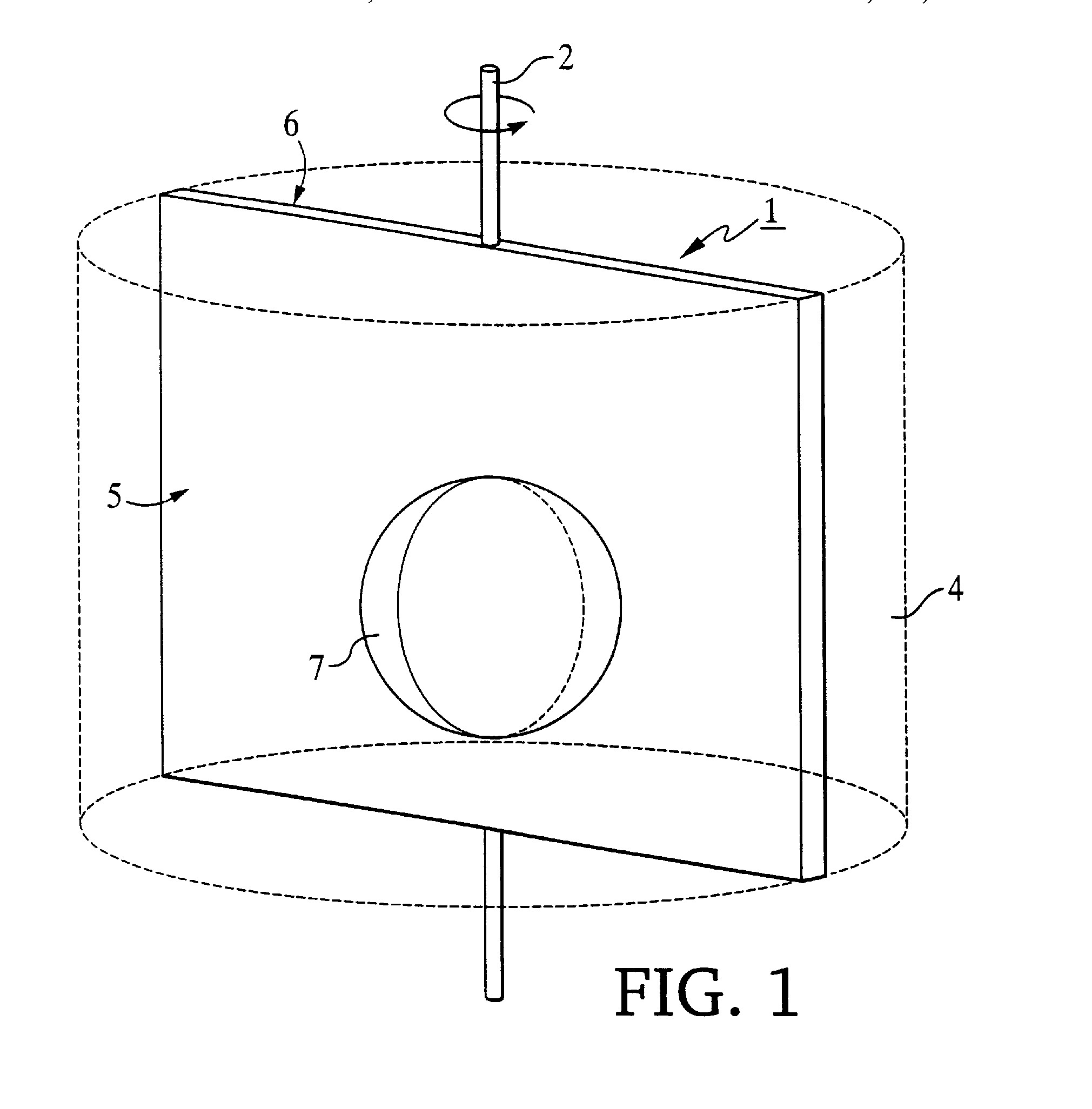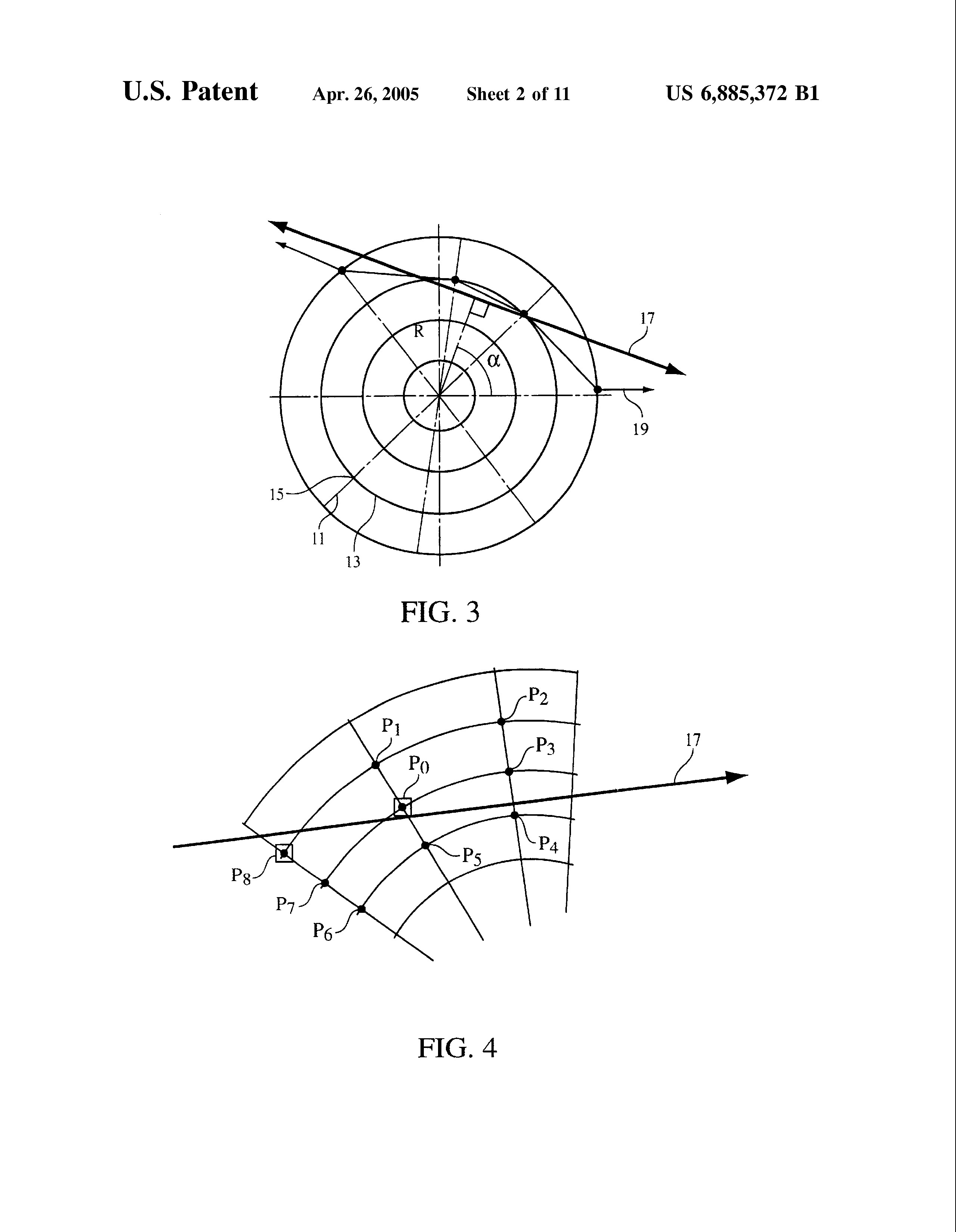
|


|

|
Either scroll down to view the complete Hall of Fame or choose the type:
The Felix3D Team has spent a lot of time researching the history of volumetric imaging. Nevertheless we ask you to help us by completing this Hall of Fame, so please send us descriptions and pictures of yet unknown (or here only preliminary stated) experimental setups or prototypes. We would be glad for any new descriptions and if possible one photo of the display and one of the researching team.
swept volume techniques
a) flat surface display
b) curved surface display
c) oscillating screen display
static volume techniques
d) solid state display
e) gaseous state display
other techniques
f) miscellaneous display type
Flat surface swept volume displays


|
 High Brightness CRT Projection
High Brightness CRT Projection
ITT Laboratories
1960
USA
|
One of the early techniques, presented by the ITT Laboratories in 1960, consists of an especially programmed high brightness cathode ray tube (CRT) whose blips are optically transferred to a translucent rotating screen within a glass cylinder.
|
|
|
|
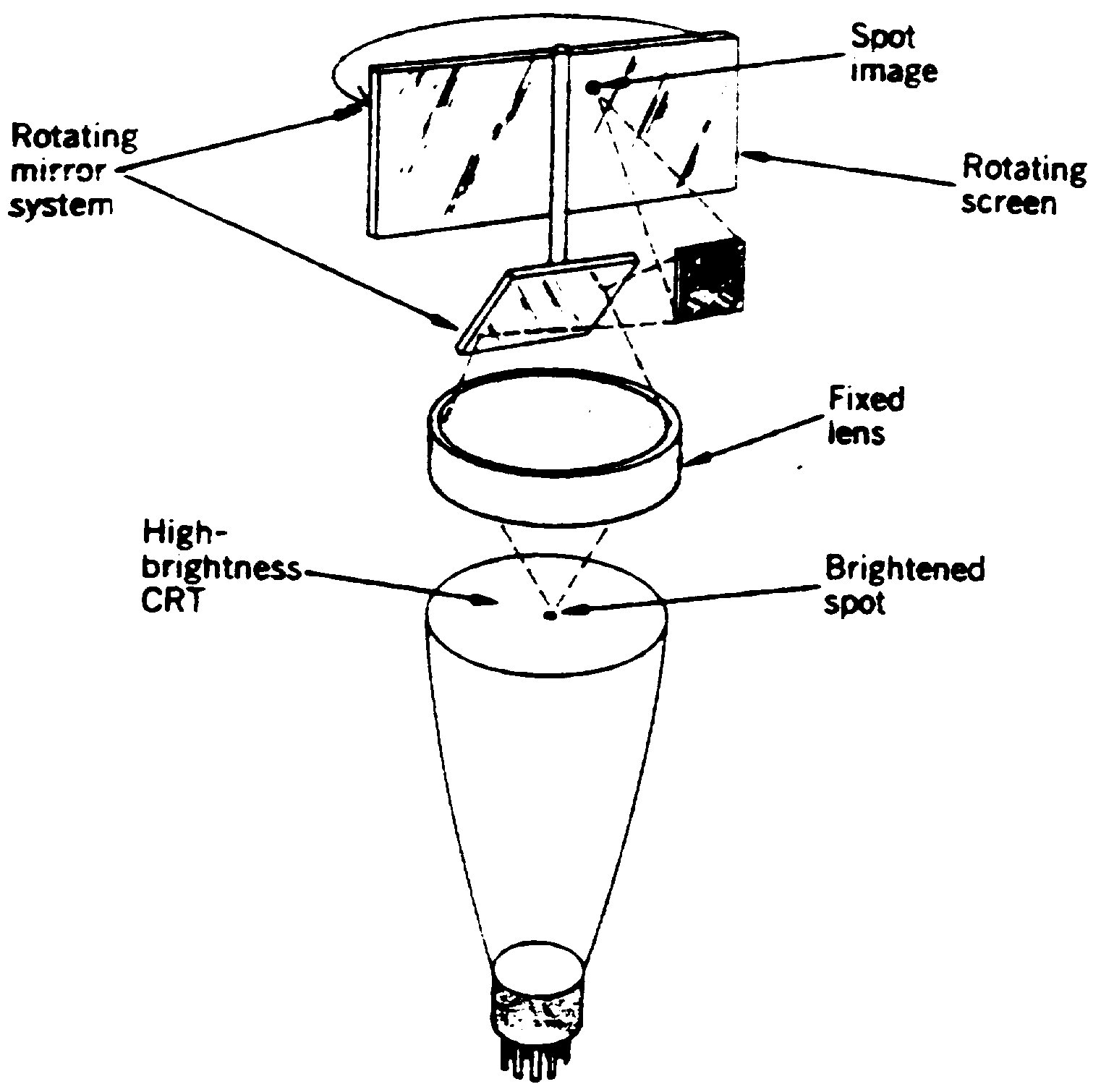
|
|
Fig. 2: Experimental sketch
|
|
|
|


|
 Electroluminiscent Panel
Electroluminiscent Panel
R. J. Schipper
1961
|
Electroluminiscent panel
|
|
|
|


|
 Three Dimensional Display Apparatus
Three Dimensional Display Apparatus
Hirsch, Max
1961
|
|
|
|
|


|
 Cathode Ray Tube Imager
Cathode Ray Tube Imager
R. D. Ketchpel
1962
|
In another arrangement, introduced by R. Ketchpel in 1962, a phosphor-coated flat screen rotates in a vacuum, with a controlled electron beam striking its surface
Developed by R. D. Ketchpel, "Direct-View Three-Dimensional Display Tube", publicated in IEEE Transactions on Electron Devices, pp. 324-
328, September 1963.
|
|
|
|


|
 Three dimensional unaided viewing method and apparatus
Three dimensional unaided viewing method and apparatus
Robert B. Collender
1965
|
|
|
|
|


|
 Rotating LED Array
Rotating LED Array
E.P. Berlin (MIT)
1979
Boston
USA
|
E.P. Berlin developed a volumetric display system at the MIT in 1977. He proposed using an active 2D matrix of light emitting diodes (LEDs) with the display electronics residing on the rotating matrix.
|
|
|
|


|
 Image storage and display
Image storage and display
Mezrich, Reuben S.; Colleoni, Alec;
1981
|
Images and respectively associated timing marks are arrayed, as phototransparencies, about a disk. The disk is rotated and the timing marks are sensed. Display occurs either in two-dimensional fashion, such as in a television system, or in three-dimensional fashion such as in a semitransparent full image projection. Associated logic circuitry determines whether the full 3-D transparency is to be produced, in which case all images on the disk are to be illuminated, or whether swim through will occur, either on an image at a time or on a "ham slice" projection basis.
|
|
|
|


|
 Three-dimensional volumetric display system
Three-dimensional volumetric display system
Solomon, Dennis J.
1991
|
The image projector apparatus is the display of the two-dimensional; data-storage format by means of an imaging display which employs a moving screen and a matrix transformation thereby creating a three dimensional reconstruction of the object space.
|
|
|
|


|
 Rotating flat screen fully addressable volume display system
Rotating flat screen fully addressable volume display system
Batchko, Robert G.
1992
|
A rotating flat screen fully addressable volume display system incorporates a rotating flat screen upon which is projected a two-dimensional scanned image. The rotating screen serves to decode the image, creating a three-dimensional display of that image in a full cylindrical volume of space. A system of reflectors, rotating in unison with the screen, is positioned between the screen and the two-dimensional image generator to allow the two-dimensional image to strike the surface of the rotating screen at a constant angle throughout rotation. The display is capable of being presented in color and updatable in real time.
|
|
|
|


|
 3D Rotatron
3D Rotatron
S. Shimada
1993
|
S. Shimada, A New Approach to the Real-Image 3D Globe Display, Society for Information Display, SID 93
Digest, pp. 1001-1004, 1993.
|
|
|
|


|
 Actuality Systems
Actuality Systems
G. Favalora
1996
USA
|
Gregg Favalora (Actuality Systems, Inc.) recently set up a volumetric display, implementing state-of-the-art hard- and software. A high resolution projection engine illuminates a diffuse projection screen that rotates with projection optics and corresponding relay mirrors.
|
|
|
|


|
 Multiple angle projection for 3-D imagery
Multiple angle projection for 3-D imagery
Martin, Donald Lewis Maunsell
1997
|
The method and apparatus function to form three-dimensional imagery on plural screen surfaces (2) which are formed by changing planes of imagery. One or more projectors (4) project a plurality of images onto the screen surface from a common axis. The planes of imagery on the screens (2) which are projected by said one or more projectors (4), change at such a speed that, to the eye, the images appear simultaneously in three-dimensional form on said screen surfaces (2).
|
|
|
|


|
 Three dimensional display system
Three dimensional display system
Blundell, Barry George
1997
|
A three-dimensional display device comprising an evacuated enclosure (45). A phosphor coated screen (44), means to rotate the phosphor coated screen, one or more electron gun (41-43) and control means to drive the one or more electron gun. Sequential image Frames (FIGS. 2b-2f) are written to the rotating phosphor coated screen (44) by the one or more electron gun (41-43) for a number of image sectors. Provided the screen rotates sufficiently rapidly and the phosphor coating has the required persistence the human eye will perceive a three-dimensional image within the display volume swept out by the phosphor coated screen. In the preferred embodiment the planar screen (44) rotates about a vertical axis with three electron guns (41-43) located below the display volume directed upwardly towards the center of the display volume. In another embodiment the display screen is in the form of a helix (51) with the electron gun (52) being aligned substantially along the axis of rotation of the helix.
|
|
|
|


|
 Method and apparatus for displaying three-dimensional volumetric images
Method and apparatus for displaying three-dimensional volumetric images
Tsao, Che-Chih
1998
|
This invention relates generally to new and improved approaches for displaying volumnetric three-dimensional (3D) images. The basic idea features new optical-mechanical mechanisms enabling creation of volumetric 3D images by successive projection of whole frames of 2D images. This new method projects a series of frames of 2D images, through an optical-mechanical image delivery system, onto a translucent screen which moves periodically and sweeps a space. As viewed from outside the space, the series of 2D images distributed in the space form a volumetric image because of the after-image effect of human eyes. Many viewers can walk around the space and see the image from omni-directions simultaneously without wearing any kind of glasses.
|
|
|
|


|
 Video image rotating apparatus
Video image rotating apparatus
Gribschaw; Franklin C.; Lang; Paul W.; Tadic-Galeb; Biljana
2000
|
An image rotating apparatus presents a projected video image upon a rear projection screen that is rotated extremely rapidly about a vertical axis which exactly bisects the picture in the vertical plane. The rotational rate is such that an entire audience, regardless of their position about the apparatus, can view the projected video image simultaneously. The video image rotating apparatus utilizes light valve technology to create red, green and blue images from an analog composite video signal, and a Phillips prism that aligns the images produced by the light valves for projection through an optical system. The image produced by the light valves is rotated, either mechanically or electronically, in synchronization with rotation of the projection screen. The projection screen itself eliminates the need for a separate shutter by both expanding the projected image generally parallel to the screen's axis of rotation, and constricting the width of the projected image generally perpendicularly to the screen's axis of rotation.
|
|
|
|


|
 Three-dimensional display system
Three-dimensional display system
LoRe; Andrew G.; Favalora; Gregg E.; Giovinco; Michael G.
2001
|
A three-dimensional display system is disclosed which includes a display target that receives a projected image and that rotates about an axis to form a three-dimensional image from the projected image. The display target has front and back surfaces that meet at locations relative to the axis to form tapered edges. Scanning optics directs light to the display target to form the projected image. A controller controls operation of the display target and the scanning optics.
|
|
|
|


|
 Process for transforming two-dimensional images into three-dimensional illusions
Process for transforming two-dimensional images into three-dimensional illusions
Lee, Elaine W.
2003
|
Methods, devices and systems for transforming two-dimensional images into three-dimensional illusions. A plurality of transparent or semi-transparent rods are configured in an annular configuration and mounted to a platform. The rods are rotated by a motor. Using a light source, a two-dimensional image is projected onto the rotating rods to kinetically transform the two-dimensional image into a three-dimensional illusion that seems to move through space.
|
|
|
|


|
 Rasterization of lines in a polar pixel grid
Rasterization of lines in a polar pixel grid
Baxter, III, William V.; Giovinco, Michael
2005
|
A method of rasterizing a line on a display having pixels with locations defined by a polar coordinate system uses the sign of a discriminant to choose which of two candidate pixels is to be the next pixel on the rasterized line. The discriminant, which is derived from the desired line, is evaluated at a point in the neighborhood of the candidate pixels. The discriminant value depends on the local slope of the line in polar coordinates. The method divides the line into segments having selected ranges of slope and rasterizes the desired line along each segment.
|
|
|
|


|
 System for physical rotation of volumetric display enclosures to facilitate viewing
System for physical rotation of volumetric display enclosures to facilitate viewing
Balakrishnan, Ravin; Kurtenbach, Gordon Paul; Fitzmaurice, George William
2006
|
The present invention is a system that allows a user to physicaly rotate a three-dimensional volumetric display enclosoure with a corresponding rotation of the display contents. The rotation of the enclourse is sampled with an enconder and the display is virtually rotazed by a computer maintaining the scene by an amount corresponding to the physical rotation before being rendered. This allows the user to remain in one poisition while viewing different parts of the scene corresponding to different viewpoints. The display contents can be rotated in direct coreespondence with the display enclourse or with a gain (positive or negative) that accelerates the rotation of the contents with respect to the physical rotation of the enclourse. Any display widgets in the scene, such as a virtual keyboard, can be maintained statinary with respect to the user while scene contents rotate by applying a negative rotaitoinal gain to the widgets. The rotaition can also ba controlled by a time value such that the rotation continues until a specified time is reached or expires.
|
|
|
|
|
|
|


